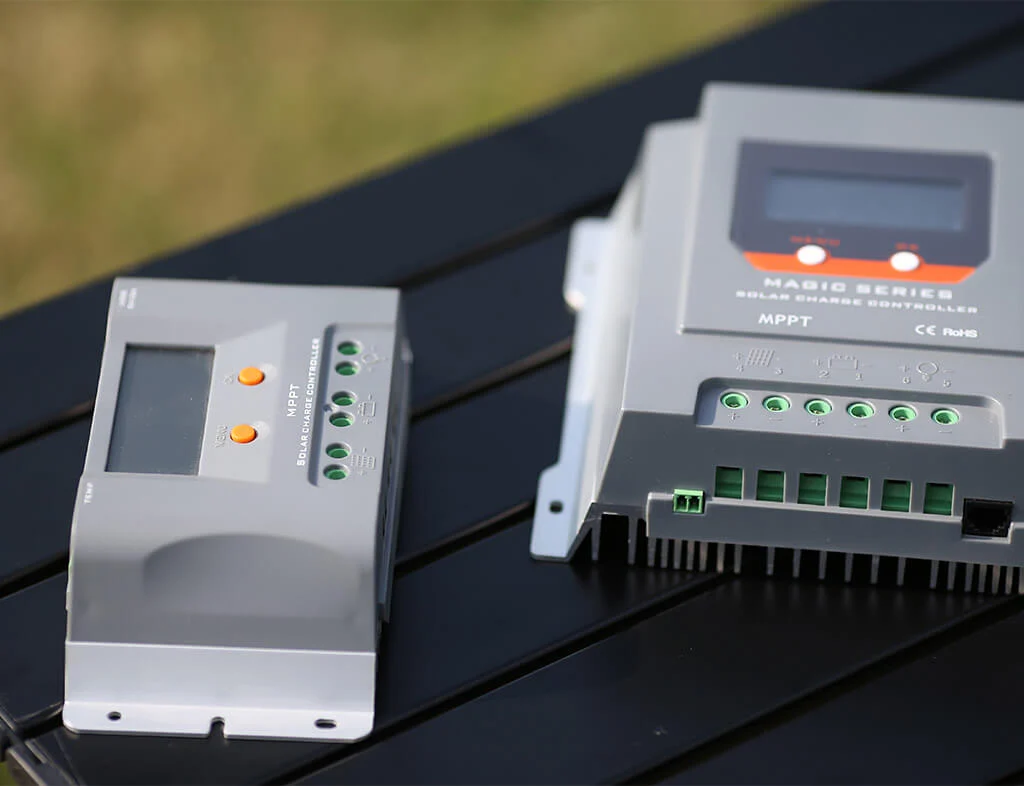When your solar panels gather sunlight, they often produce more power than your batteries can handle. You need a way to manage this power going into the battery to make it as efficient as possible. That’s where a solar charge controller comes in.
The power from your panels to your battery has two parts: voltage and amperage. Voltage is like the pressure of the electricity, and amperage is the flow rate. Together, they make up the total power, measured in watts. To get the most power, you want to make sure you’re getting the best mix of voltage and amperage.
An MPPT solar charge controller is a special kind of tool that takes the high voltage from the solar panels and converts it to a level that your battery can handle. This way, you don’t waste any energy.
MPPT stands for Maximum Power Point Tracking. Your solar panels’ efficiency can change based on a lot of things like the time of day, clouds, or how hot the panels are. MPPT finds the best setting where your system will produce the most power.
How Does MPPT Solar Charge Controller Work?
Your solar system works best when it’s in sync with your batteries. Too much or too little power and you’ll either lose energy or not store enough. You need just the right amount at all times.
The total power your solar system can make is calculated by multiplying the amps by the volts. If your battery can only take in 12 volts, then the amps have to be set right to meet the panel’s full power output.
Trying to sort this out by hand is tricky. The panel has to give more voltage than what the battery needs for a balanced system. You want to reach the “maximum power point,” where your panel gives the most energy without losing too much in the process.
Things like the sun’s angle, clouds, and weather can change the best amps and volts setting throughout the day. You can’t just do a one-time calculation for this.
That’s why you need an MPPT charge controller. It keeps an eye on all these factors and adjusts them for you. This helps your system stay close to the “maximum power point,” making it run as efficiently as possible.
Differences Between MPPT Solar Charge Controller and PWM
The MPPT and PWM charge controllers are the two main solar charge controller types you’ll find for solar systems. The PWM controller uses a switch that quickly turns on and off to control the electric current from your solar panels.
The big difference is that MPPT can adjust both the current and the voltage, while PWM only controls the current. Since PWM can’t change the voltage, it can’t help but reduce the total power your panels can give.
Simply put, MPPT helps you get the best power output, while PWM only cuts down the current going into the battery.
All solar panels have a standard power rating, and a PWM controller will make your panels work less effectively than they could with an MPPT controller.
Solar systems are never fully efficient. Most panels turn only about 15-20% of the sunlight they get into electricity.
Some top-quality panels from reputable solar companies can go up to a 23% efficiency rate. A PWM controller wastes more energy as heat and only affects one part of the whole power setup, making it less efficient than an MPPT controller.
Benefits of MPPT Solar Charge Controller
Using an MPPT controller boosts your solar generator’s efficiency and performance, helping you save money and get back your initial investment faster.
Better Power Storage
Both types of controllers manage the electric current going from the solar panels to the battery.
Too much current can waste energy, but the MPPT adjusts both voltage and current, letting your system store more power.
Works Well in Any
Weather Solar power needs to store energy for times when the sun isn’t shining. On cloudy days, the best balance of power changes often.
The MPPT controller adapts to these changes, keeping your system at peak performance.
Need Fewer Panels
Getting more power from each panel means you may need fewer of them.
This not only saves money but also gives you more options for where to place the panels on your roof.
More Effective for Large Systems
As your setup grows, squeezing more power out of each panel becomes more important.
The MPPT controller can make a big difference, especially in large systems, maximizing the energy you can use.
Good Return on Investment
An MPPT controller is pricier than a PWM one, but you get more features.
Given the long-term savings on energy costs and the smaller carbon footprint, an MPPT controller helps you see these benefits sooner and more fully compared to a PWM controller.
Conclusion: Are MPPT Solar Charge Controllers Worth It?
Yes, MPPT (Maximum Power Point Tracking) solar charge controllers are generally considered worth the investment, especially for medium to large solar power systems.
Here are some reasons why they are often deemed valuable:
MPPT controllers are more efficient than PWM controllers, often converting 90-98% of the available solar power to charge the batteries. This makes the most of the energy your solar panels are generating.
Unlike PWM controllers, which require the solar panel voltage to match the battery voltage, MPPT controllers allow for greater flexibility in the types of solar panels you can use. This is advantageous for future expansions or upgrades.
Moreover, MPPT controllers adjust to changing weather conditions and ensure that you’re getting the most power into your batteries whether it’s cloudy or sunny. They are particularly effective in low-light conditions.








